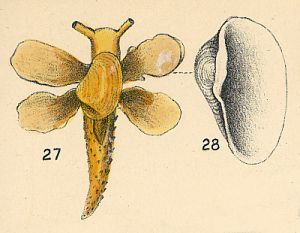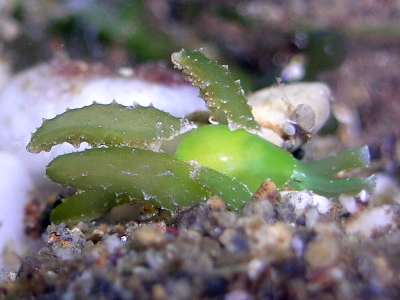

Lobiger serradifalci
(Calcara, 1840).
Order: SACOGLOSSA
Family: Oxynoidae
DISTRIBUTION
Mediterranean
PHOTO
UPPER: Albenga, Italy, October 18, 1998 on Caulerpa taxifolia. size: ~ 2 cm, depth: ~ 5 m. Photo: Olivier Dugornay.
LOWER: An illustration by Vayssiere of Lobiger serradifalci (Calcara, 1840) from Pilsbry, 1896: Pl. 10.
•See separate page for full Reference List for Lobiger serradifalci
• See general Lobiger references.
Rudman, W.B., 2001 (November 7) Lobiger serradifalci (Calcara, 1840).. [In] Sea Slug Forum. Australian Museum, Sydney. Available from http://www.seaslugforum.net/find/lobiserr
Related messages
Lobiger serridifalcii from Turkey
January 22, 2004
From: Levent Cavas

Dear Dr.Rudman,
I have taken a good pic of Lobiger serridifalcii, in my aquarium
If you want, you can use it in your web site.
Cordially,
Levent Cavas
Dokuz Eylul University
Tinaztepe Campus
IZMIR-TURKEY
lcavas@deu.edu.tr
Cavas, L., 2004 (Jan 22) Lobiger serridifalcii from Turkey. [Message in] Sea Slug Forum. Australian Museum, Sydney. Available from http://www.seaslugforum.net/find/11979Thanks Levent,
Bill Rudman
Re: Lobiger serradifalci from the Mediterranean
November 11, 2001
From: Erwin Köhler

Hi Bill,
Here is a photo of Lobiger serradifalci from Albenga, Italy on Caulerpa taxifolia.
size: ~ 2 cm,
depth: ~ 5 m
October 18, 1998
Photographer: Olivier Dugornay,
Olivier.Dugornay@ifremer.fr
Cheers Erwin
[See Erwin's Mediterranean Slug Site]
Erwin@medslugs.de
Köhler, E., 2001 (Nov 11) Re: Lobiger serradifalci from the Mediterranean. [Message in] Sea Slug Forum. Australian Museum, Sydney. Available from http://www.seaslugforum.net/find/5659Thanks Erwin,
It is interesting to see the bifurcating tips to the parapodial lobes. I can't find any mention in the literature of such a character so it may be something unusual in this specimen.
I see it is on the introduced Caulerpa taxifolia. In a recently published paper it says that Lobiger serradifalci, which naturally feeds on Caulerpa prolifera, has begun to settle and feed on C. taxifolia. However, rather than helping to control the spread of this introduced algae it may in fact be hastening its spread. In the Mediterranean, at least, C. taxifolia is reproducing vegetatively, by small pieces breaking off and growing into new plants. Unfortunately, Lobiger serradifalci feeds by piercing holes in the cell wall, which weakens the plant and allows pieces to break off, so hastening the spread of the algae. Unfortunately nothing is simple!
Reference: • Zuljevic A., Thibaut T., Elloukal H., Meinesz, A. (2001) Sea slug disperses the invasive Caulerpa taxifolia. Journal of the Marine Biological Association, UK, 81: 3761/1-2.
Best wishes,
Bill Rudman
Lobiger serradifalci from the Mediterranean
November 9, 2001
From: Bill Rudman

As background for the on-going discussion on Lobiger viridis here is some information on the Mediterranean species Lobiger serradifalci (Calcara, 1840).
PHOTO: An illustration by Vayssiere of Lobiger serradifalci (Calcara, 1840) from Pilsbry, 1896: Pl. 10.
Thompson (1988) gives a full description of this species. The parapodial flaps do not have secondary branches or crenulations along the edge of the flaps. There is a notch at tip of radular teeth, and Thompson describes "thorn-like lateral denticles" on the smaller teeth.. These are lost in the larger, more recent teeth.
Reference:
• Thompson, T.E. (1988) Eastern Mediterranean opisthobranchia: Oxynoidae, Polybranchiidae, Stiligeridae (Sacoglossa). J. Moll. Stud., 54: 157-172.
